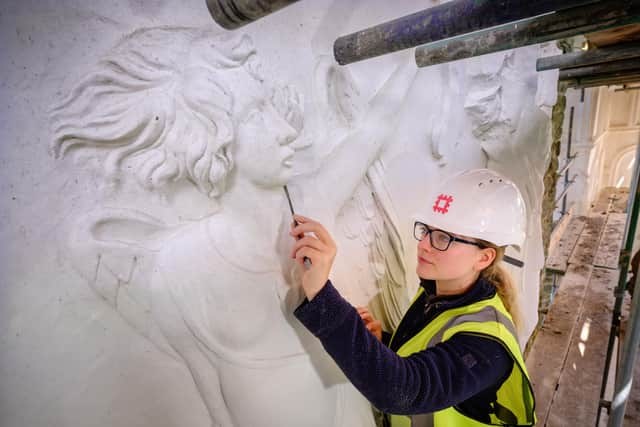400-year-old decorative friezes at Hardwick Old Hall are preserved
and live on Freeview channel 276
The plaster panels, which depict plants and animals, are all that remains of the interior decor of the property which was built by Bess of Hardwick between 1587 and 1596. In their heyday, the friezes would have been vividly painted but they have been exposed to the elements for two centuries as the Old Hall deteriorated into a roofless ruin.
Using specialist skills, experts have managed to stablise and preserve these original features which were considerably damaged not only by exposure to the weather but also historic repairs now recognised as inappropriate. Decorative plaster on the whole west wall facing the valley has been conserved and the team has completely reinstated the render on the building after matching what was historically applied.
Advertisement
Hide AdAdvertisement
Hide AdInnovative for their time, the panels provided prototypes for features later incorporated into Hardwick Hall – a property that Bess began building immediately next door while the Old Hall was still unfinished. The friezes include one showing the giants Gog and Magog who were defeated by Brutus, the legendary founder of Britain.


Jeremy Ashbee, who is English Heritage’s head properties curator, said: “Rising from a modest background to become one of the richest women of her time, and certainly the most famous woman after Queen Elizabeth I, Bess of Hardwick was also a tireless and ambitious builder, whose houses symbolised her rise to wealth and power.
"The remaining plaster panels at Hardwick Old Hall provide the sole remaining interior decor of the property and are so pivotal in understanding the grandeur of the interior and the tastes of Bess herself. Our experts, over the course of seven months have painstakingly conserved these important historic interiors and exteriors, which are completely exposed to the elements, to save them for future generations.”
Hardwick Old Hall was one of the most innovative houses of the Tudor period, drawing on the latest Italian house designs and was a reflection of Bess’s style and status.
Advertisement
Hide AdAdvertisement
Hide AdBess outlived her four husbands. She married Robert Barlow at the age of 15 but he died within a year of their wedding. Her second husband was Sir William Cavendish with whom she bought the estate of Chatsworth where they built a new house. Her third husband, Sir William St Loe, was one of Queen Elizabeth’s courtiers and Bess soon became an inimate friend of the monarch. Bess’s fourth marriage was to George Talbot, 6th Earl of Shrewsbury who was one of the richest men in the country.